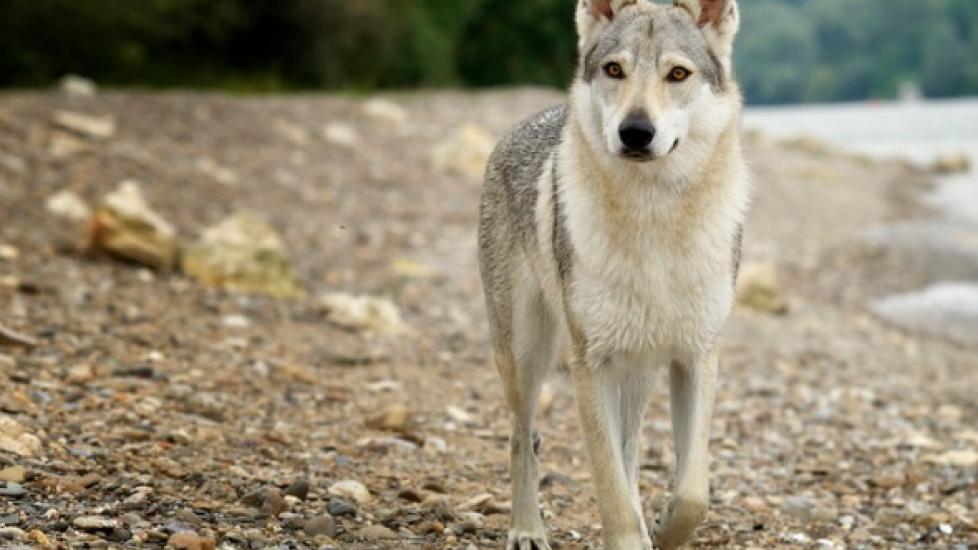8 Differences Between Dogs and Wolves
Reviewed for accuracy on November 26, 2018, by Dr. Katie Grzyb, DVM
Whether your dog is a Dachshund, Border Collie or Alaskan Malamute, she’s related to the wolf. Scientists estimate that between 15 and 40 thousand years ago, dogs broke off from wolves. Dog breeds evolved in the last one to two thousand years, with the vast majority arising in the past 100 to 200 years, says Dr. Angela Hughes, veterinary genetics research manager at Wisdom Health, the producer of Wisdom Panel dog DNA tests.
Dog evolution occurred as a result of association with human tribes. “As humans created refuse piles near their camps, some wolves saw this as a means of easy scavenging. The wolves that were less fearful would have likely been more successful at this scavenging by virtue of their ability to get closer to the humans, and the more successful animals would be more likely to pass their genes on to future generations. Over many, many generations, it is thought that these animals became domesticated, learned to read human cues, and developed more intimate relationships with humans, even becoming guardians and companions,” says Dr. Hughes.
Wolves and dogs belong to the species, Canis lupus. They share more than 99 percent of their DNA, and while it doesn’t happen very often, they can technically interbreed, according to Dr. Hughes. The Alaskan Malamute, Siberian Husky and other dogs that look like wolves are more closely related to the wolf, than say, a Poodle is. Still, all dog breeds are more closely related to each other than they are to the wolf.
Less than 1 percent may not seem like a lot, but it’s enough to create significant differences between dogs and wolves. Given the great variations in dog breeds, the following are generalizations.
1. Physical Differences Between Dogs and Wolves
Both wolves and dogs have the same number of teeth, but they, along with the skull and jaw, are larger and stronger in the wolf. “This is likely due to their need to bite and break things like bones in the wild, compared with dogs who evolved much more as scavengers of human refuse,” says Dr. Hughes.
Dogs have rounder faces and larger eyes than wolves, says Jenn Fiendish, a veterinary behavior technician who runs Happy Power Behavior and Training in Portland, Oregon. “They also evolved to have floppy ears and curly or short tails, while the wolf has pointed ears with a long, sickle-type tail,” she says.
Wolves have enormous feet compared to a dog’s, and their two front, middle toes are much longer than their side toes, says Kent Weber, co-founder and director of Mission: Wolf, a refuge for wolves and wolf-dogs located in Westcliffe, Colorado. “With that, they can spring off of their toes, flex their longer ankles, keep their elbows right together and spring at incredible distances. That’s how a wolf can conserve energy and go so far compared to a dog.”
Recommended Products
2. They Differ in Their Dependence on Humans
Dogs can’t survive without humans, says Joan Daniels, associate curator of mammals at Brookfield Zoo in Brookfield, Illinois. “There are some feral dogs out there in the wild, but generally those dogs don’t do well because they’ve been domesticated to the point where they can no longer adequately survive,” she says.
If you’re familiar with dogs, you may know that they’ll obey commands like sit and stay because they want to please humans and get rewarded, says Michelle Proulx, director of Animal Caretaker and Educational Programs at W.O.L.F. Sanctuary in Laporte, Colorado. Wolf behavior differs. “We’ll be trying to get [wolves] to do a behavior, and eventually they’ll look at me and they’ll be like, ‘You’re making this too hard,’ and they’ll walk off and they’ll go find something else to eat. They’re like, ‘I have food, I can go find my own.’”
Studies confirm Proulx’s observations. “There have been many studies regarding the ability to train wolves as you would a domestic dog. Those studies did find that wolves fail to form attachments to humans and do not show the same behaviors as a domesticated dog would,” says Fiendish.
3. Wolves Mature Faster Than Dogs
Both wolf and domestic dog pups are weaned at about 8 weeks. Yet, “Wild wolf puppies mature much faster than domestic dogs,” says Regina Mossotti, director of Animal Care and Conservation at Endangered Wolf Center in Eureka, Missouri.
Studies comparing the ability of dogs and wolves show that wolf pups can solve puzzles at a much younger age, she says. “And it makes sense. They have to mature must faster to be able to survive in the wild, whereas domestic dog puppies have us to care for them. It’s a little bit of an easier life,” she says.
When your dog turns 2 years old, she’ll likely still be your lifelong and loyal companion. Experts say wolves will be a good companion for about six months, at which point they can become hard to handle. Wolf and wolf-dog sanctuaries say they regularly get calls when the animal reaches sexual maturity.
4. Wolves and Dogs Breed Differently
Unlike dogs who can breed several times throughout the year, wolves breed only once a year. They also have a rigid breeding season that occurs from February through mid-March, with pups being born in April and May, says Mossotti.
Their litter sizes differ, too, she says. A wolf averages about four to five pups, whereas dog litters can vary. “We’ve seen with a lot of domestic dogs, their litters are on average about five to six pups, but you see more instances where many different domestic dog breeds can have larger litter sizes.”
Although both wolf and dog mothers care for and nurture their pups, dogs care for their young without the help of dad, says Laura Hills, owner of The Dogs’ Spot, based in North Kansas, Missouri. “Wolf packs are made up of a mother and a father wolf and their offspring. Dogs on the other hand, do not form familial groups in the same manner.”
5. Play Means Different Things
A domestic dog plays primarily for fun. For a wolf pup, play is critical for learning survival and social skills, says Mossotti. “It teaches them how to hunt; it teaches them how to learn how to discipline a pack member when they become leaders. It helps them learn what their limits are, just like human kids. That social learning is very important so when they grow older, their packs know how to talk to each other and work together and respect each other so they can hunt together and keep the pack healthy.”
Experts say dogs also need to learn social boundaries, but that those skills are not as critical as they are in wolves. These differences in dog behavior are also evident throughout adulthood, says Fiendish. “Unlike wolves, dogs play continually throughout their life and will also socialize with multiple species and even show affiliative behaviors.”
6. Dog Nutrition vs. Wolf Nutrition
Dogs are omnivores who evolved to eat what we eat. In contrast, “A wolf’s GI system can process raw meats, go longer without meals, and absorb nutrients in a different manner than that of a domestic dog. This is an important item to remember when choosing a food type for your pet dog, as their ability to stave off common pathogens in raw foods is very limited,” says Fiendish.
Mossotti says wolves will sometimes eat plant materials, but that they’re true carnivores. They also eat more than dogs do. “Wolves know that it’s probably going to be a long time between meals or it will get stolen, so they can eat a ton at once. They can actually hold between 10 and 20 pounds, depending on the species. With domestic dogs, we give them [for example] a cup of food in the morning and a cup in the afternoon.”
A domestic dog being fed wolf kibble would probably get sick and have diarrhea because of the high level of protein, says Daniels. Conversely, “If I fed a domestic dog food to a wolf, that wolf would have deficiencies.”
7. Wolves Are Shy; Dogs Are Usually Not
Despite being portrayed in some outlets as vicious, experts say that wolves are actually shy and will avoid people. It’s also incredibly rare that a wolf will attack a person.
When she was researching wolf behavior as part of the Yellowstone Wolf Project, Mossotti and her team would approach the prey the wolves had just taken down. “You would think these are things they’d want to protect and take you on, but they run away.”
Wolf-dogs are a little of both. “If you combine that strength, intelligence and wildness of a wolf, and combine it with a lack of fear that dogs have, that could be a pretty serious situation,” says Mossotti.
8. Wolves Are Stronger Problem Solvers
Studies looking at problem-solving abilities in wolves and dogs show that when a problem becomes more difficult, dogs will eventually quit, says Proulx. “They kind of look for a person and say, ‘Come figure this out and fix this for me,’ whereas a wolf will try to figure it out by themselves.”
In one study, dogs and wolves had to work together to solve a puzzle in order to get a treat. “They had to pull a rope at the same exact time in order for the tray to slide in and give them foods. The wolves figured it out quickly. The dogs never really figured out the problem until they had a human teach them that they need to pull the rope. Even more fascinating was that when the testers made the puzzle more challenging, the wolves still succeeded. The wolf would wait until the other wolf was let into the experiment, so they could get the treat together.”
The differences between dogs and wolves are stark enough that experts recommend against keeping wolves and wolf-dogs as domestic companions. “We have four or five animals here right now that look like a wolf in some regards. If you put them in an animal shelter, they have to euthanize them because they can’t adopt out animals that are part-wild. The reality of it is, they’re nice dogs,” says Weber.
Given these facts about wolves, if you have your heart set on the wolf look, experts recommend adopting a breed like the Akita, Alaskan Malamute, Samoyed, Husky and German Shepherd.
Image via iStock.com/s-eyerkaufer




